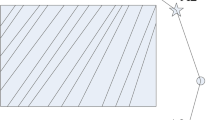Abstract
Multi-hop localization schemes are low cost, easy to implement and suitable for large-scale application. However, in practical applications, the performances of multi-hop localizations are often affected by anisotropic networks, such as irregular deployment of nodes and uneven distribution of nodes. The anisotropic problem makes the application of multi-hop localization limited, so we propose a new multi-hop approach for anisotropic network. This scheme constructs the mapping relation between hop-counts and physical distance and this algorithm views the process of location estimation as a regression prediction. In addition, we employ the geometric precision factor (Geometric Dilution Precision) to select the anchors, and effectively avoid the problem of the error amplification of the geometric relations of the anchors. Theoretical analysis and simulation results show that our proposed method can adapt to different environments, and the method has the advantages of small overhead, high precision without setting complex parameters.
Similar content being viewed by others
References
Zekavat, R. and Buehrer, R.M., Handbook of Position Location: Theory, Practice and Advances, Hoboken: John Wiley & Sons, Inc., IEEE Press, 2011.
Amitangshu Pal, Localization algorithms in wireless sensor networks: Current approaches and future challenges, Network Protoc. Algorithms, 2010, vol. 2, no. 1, pp. 45–73.
Asma Mesmoudi, Mohammed Feham, and Nabila Labraoui, Wireless sensor networks localization algorithms: A comprehensive survey, Int. J. Comput. Networks Commun., 2013, vol. 5, no. 6, pp. 45–64.
Rufei Ma, Erwu Liu, Rui Wang, et al., Energy-aware preferential attachment model for wireless sensor networks with improved survivability, KSII Trans. Internet Inf. Syst., 2016, vol. 10, no. 7, pp. 3066–3079.
Shekhar, S., Feiner, S.K., and Aref, W.G., Spatial Computing, Commun. ACM, 2016, vol. 59, no. 1, pp. 72–81.
Yan, X. Song, A., et al., An improved multihop-based localization algorithm for wireless sensor network using learning approach, Comput. Electr. Eng., 2015, vol. 48, no. 2015, pp. 247–257.
Liu, Y. and Yang, Z., Location, Localization, and Localizability Location-awareness Technology for Wireless Networks, Springer, 2011.
Yan, X., Yang, Z., Liu, Y., et al., Incremental localization algorithm based on regularized iteratively reweighted least square, Found. Comput. Decision Sci., 2016, vol. 41, no. 3, pp. 183–196.
Liu, X., Zhang, S., and Bu, K., A locality-based range-free localization algorithm for anisotropic wireless sensor networks, Telecommun. Syst., 2015, vol. 62, no. 1, pp. 3–13.
Zhang, S., Liu, X., Wang, J., et al., Accurate range-free localization for anisotropic wireless sensor networks, ACM Trans. Sensor Networks, 2015, vol. 11, no. 3, pp. 1–28.
Niculescu, D. and Nath, B., DV based positioning in ad hoc networks, Telecommun. Syst., 2003, vol. 22, nos. 1–4, pp. 267–280.
Nagpal, R., Shrobe, H., and Bachrach, J., Organizing a global coordinate system from local information on an ad-hoc sensor network, in Information Processing in Sensor Networks, Zhao, F. and Guibas, L., Eds., Springer Berlin Heidelberg, 2003, pp. 333–348.
Kleinrock, L. and Silvester, J., Optimum transmission radii for packet radio networks or why six is a magic number, Proceedings of the IEEE National Telecommunications Conference, 1978, pp. 4.3.1–4.3.5.
Lim, H. and Hou, J.C., Distributed localization for anisotropic sensor networks, ACM Trans. Sensor Networks, 2009, vol. 5, no. 2, pp. 1–26.
Lee, J., Chung, W., and Kim, E., A new kernelized approach to wireless sensor network localization, Inf. Sci., 2013, vol. 243, no. 2013, pp. 20–38.
Lee, J., Choi, B., and Kim, E., Novel range-free localization based on multidimensional support vector regression trained in the primal space, IEEE Trans. Neural Networks Learn. Syst., 2013, vol. 24, no. 7, pp. 1099–1113.
Xiao, Q., Xiao, B., Cao, J., et al., Multihop range-free localization in anisotropic wireless sensor networks: A pattern-driven scheme, IEEE Trans. Mobile Comput., 2010, vol. 9, no. 11, pp. 1592–1607.
Xiao, B., Chen, L., Xiao, Q., et al., Reliable anchor-based sensor localization in irregular areas, IEEE Trans. Mobile Comput., 2009, vol. 9, no. 1, pp. 60–72.
Yan, X., Song, A., and Yang, Z., Toward collinearity-avoidable localization for wireless sensor network, J. Sensors, 2015, vol. 2015, no. 2, pp. 1–16.
Author information
Authors and Affiliations
Corresponding author
Additional information
The article is published in the original.
About this article
Cite this article
Yao, J., Yan, X. & Dou, R. An anisotropic-tolerant and error control localization algorithm in wireless sensor network. Aut. Control Comp. Sci. 51, 442–452 (2017). https://doi.org/10.3103/S0146411617060104
Received:
Accepted:
Published:
Issue Date:
DOI: https://doi.org/10.3103/S0146411617060104




